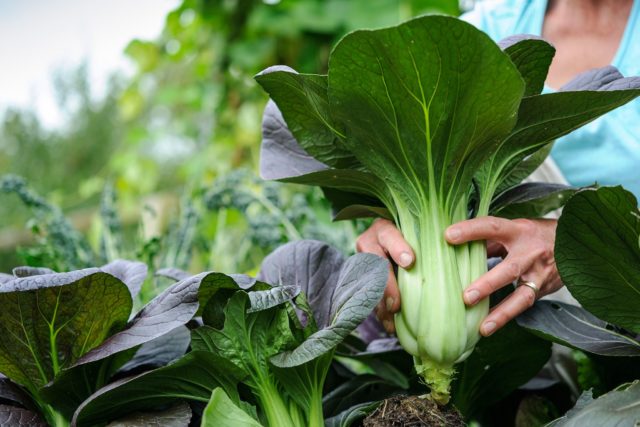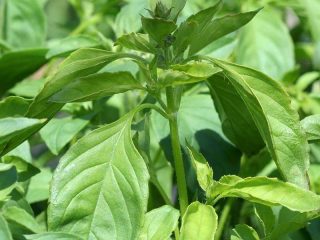Content
Pak choi cabbage is a leafy, two-year, early-ripening crop. Like the Beijing one, it does not have a head of cabbage and looks like a lettuce. The plant has different names depending on the area, such as celery and mustard.
Description of Chinese cabbage Pak choi
Pak choy is a relative of Chinese cabbage, but has many differences - both external and taste. Its leaves are darker, rougher, with smooth edges. The taste is sharper, piquant.
Pak choi looks very impressive in the garden. Cabbage leaves form a beautiful rosette that resembles a fancy-shaped vase. It reaches a height of 20-50 cm, a diameter of up to 45. Petioles and leaves can have different colors. In the first year, Pak choi cabbage forms only a rosette; in the second year, it produces a tall flower. After flowering many seeds appear.
The petioles of cabbage are convex, thick, and pressed. Usually their weight is one third of the entire plant. They are very crispy, juicy, and taste like spinach.
When choosing cabbage, you need to pay attention to the color of the leaves and their elasticity. They should be bright, juicy, not lethargic.
You can see the Pak choi cabbage in the photo.

Young small rosettes, which are considered more delicate, are especially valued
Advantages and disadvantages
Chinese cabbage has many benefits:
- It ripens quickly - you can eat it within a month.
- It is resistant to diseases.
- Unpretentious - unlike white cabbage: it is not afraid of cold weather, can tolerate light frosts of at least -4 ° C, is not picky about soil, and does not require careful preparation of beds for planting.
- Rich in vitamins, including A, B1, B2, C, PP, K. It contains iron, potassium, magnesium, calcium, phosphorus, as well as citric acid, pectin, fiber, and bioactive elements.
- Low-calorie - contains only 13 kcal per 100 g.
- It is actively used in cooking - it is fried, stewed, baked, pickled, boiled. Salads and various savory snacks are prepared from it.
- It looks very impressive in the garden: its leaves form a beautiful rosette that resembles a fancy-shaped vase.
Pak choy practically has no disadvantages or contraindications for use, or they are very minor.
Yield of Pak Choi
This indicator may vary depending on the variety of Pak Choi. The following are considered high-yielding (in kg/sq. m):
Variety | Kg/sq. m |
Martin | 10 |
Alyonushka | 9 |
In memory of Popova | 10 |
Four seasons | 7,5 |
Peahen | 10 |
Swan | 5-7,5 |
Less productive varieties of Pak choi cabbage:
Variety | Kg/sq. m |
Vitavir | 6,2 |
Golub | 6 |
Beauty of the East | 6 |
Corolla | 5 |
Chill | 6,5 |
Yuna | 5 |
Chingensai | 3 |
Lynn and Maggie | 3,8 |
Lilac miracle | 2 |
Stonefly | 2,7 |

Some cabbage varieties are highly productive
When to Plant Pak Choi
You can sow seeds in the soil as early as April at a temperature of +4 °C. Pak choi cabbage is planted in batches at one-week intervals, allowing you to enjoy the young leaves longer.Overgrown plants become too rough and are therefore much less valuable.
Seedlings are planted in open ground or in a greenhouse at the age of 2-3 weeks, when the cabbage sprouts have 4-5 true leaves. The air temperature outside should rise to +15-17 °C.
Growing and caring for Chinese cabbage Pak choi
To grow Pak Choi from seeds, choose a well-lit area where precipitation does not stagnate. It is recommended to prepare the bed for spring sowing in the fall. It’s good if beans, pumpkins, tomatoes, and cucumbers grew here before.
Fertilizers must be added to the soil. For each square meter you will need half a bucket of humus, 1 tbsp. l. potassium sulfate, 2 tbsp. l. superphosphate. After adding, dig up the soil to the depth of a spade bayonet. For acidic soils you need chalk, dolomite flour or slaked lime.
In the spring, the cabbage beds should be loosened, leveled, and not too deep grooves formed at a distance of 30 cm from each other. Water the soil and plant the seeds to a depth of about 1 cm. Before planting Pak Choi cabbage seeds, about two days in advance, it is recommended to treat them with a solution of microelements so that they germinate better.
After the seedlings have two leaves, they need to be thinned out so that the distance between them is approximately 30 cm.

If you want to see cabbage on the table as early as possible, it is better to grow it in seedlings.
To grow seedlings, well-moistened seeds are sown in a container with soil prepared in advance. The time for sowing cabbage depends on the climate of the region. It is usually carried out from late March to mid-April. If Pak Choi cabbage seeds are immediately planted in individual containers, there is no need to pick.Usually 2 seeds are placed in one pot, after germination a more powerful sprout is left.
Pak choy needs regular watering to keep the petioles juicy. If the soil is constantly dry, the cabbage will be tasteless and have a rough texture. But excessive moisture is not recommended; there should be enough moisture in the soil, otherwise the plant may begin to rot.
Early ripening cabbage does not need fertilizer if it was applied during the planting period. On humus-poor soils, 2 fertilizations are carried out. These are usually natural fertilizers. A solution of cow dung (1 to 10) mixed with wood ash works especially well on Pak-choi.
In a month, you can have early varieties of low-growing Pak Choi cabbage on the table if you provide it with proper care. Tall specimens will reach maturity approximately 2 weeks later.
Diseases and pests
Like most garden crops, cabbage is susceptible to diseases and pest attacks.
Pak-choi does not have many enemies, but in large concentrations they can destroy a significant portion of the crop.
To combat cruciferous flea beetle, plantings are treated once a week with a mixture of wood ash and tobacco dust, taken in equal quantities. These insects are especially dangerous for young cabbage. Potatoes, tomatoes, cumin, coriander, and dill planted around the beds with Pak Choi will help protect against this pest. It can also be flowers: marigolds, nasturtium, calendula.

The cruciferous flea beetle makes large holes in the leaves, which slows down growth
One of the popular ways to combat cruciferous flea flea is vinegar 9%.Pour a glass of vinegar into a bucket of water and spray the cabbage leaves. Among chemical agents, Kinmiks has proven itself well.
Another dangerous enemy is the cabbage white. It is best to destroy it in the initial stage. To do this, you need to periodically check the underside of the leaves of Pak Choi cabbage and neighboring plants for the presence of oviposition and remove them. It is much more difficult to fight an adult caterpillar. Folk remedies against this pest include ash, tobacco or wormwood infusion.
You can prepare mustard infusion. For 100 g of mustard powder you need to take 10 liters of water, leave for several days, then dilute by half.
Garden slugs and rain snails can significantly spoil the harvest. They are usually collected by hand or baited with alcohol infusion and bran.
Pak choy is resistant to most diseases and gardeners often manage to avoid them.
Application
Cabbage is primarily used in cooking. All parts of Pak Choi are edible - both roots and leaves. It is fried, stewed, baked with vegetables and meat, and used as a side dish.
Heat treatment kills many beneficial substances. Therefore, the best way to consume cabbage is in fresh salads, which are sources of vitamins. Bell peppers, carrots, ginger, sesame and other ingredients go well with Pak Choy. Vegetable salads are seasoned with lemon juice, olive or sunflower oil.

Chinese cabbage is convenient and easy to peel and cut
Before cooking, cabbage leaves are separated from the stem and then shredded or chopped. The latter is cut into circles.
In addition to cooking, Pak choy is used in folk medicine. It is believed to have anti-inflammatory, diuretic, and laxative properties.Juice and fresh cabbage leaves speed up the healing process of wounds and burns. The vegetable helps fight constipation, makes bones strong, and prevents the development of Alzheimer's disease. Thanks to the content of B vitamins, it has a positive effect on the nervous system.
Conclusion
Pak choi cabbage is a healthy vegetable that is loved not only for its excellent taste, but also for its ease of cultivation, unpretentiousness, and health benefits. It is a dietary product and is well suited for people who follow a healthy diet.
Reviews of Pak choi cabbage








